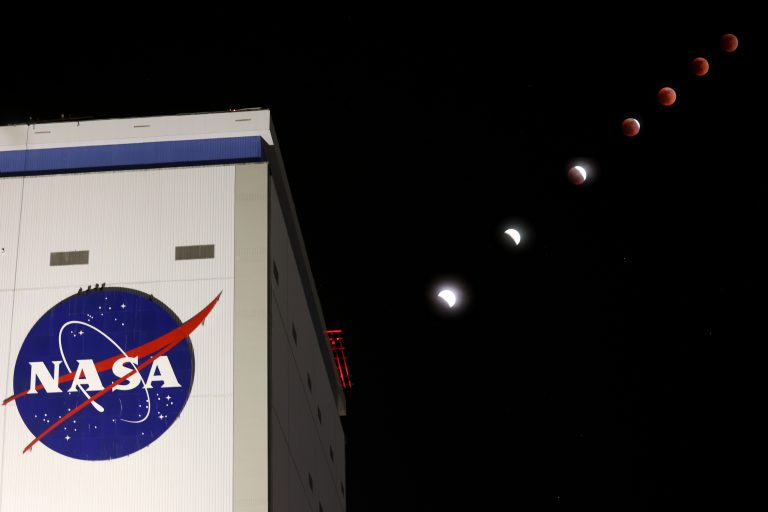Last Chance to See Total Lunar Eclipse Until 2025!
For the second time in 2022, stargazers will have the opportunity to view a total lunar eclipse on Nov. 8. At least a portion of the phenomenon will be visible throughout eastern Asia, Australia, the Pacific, and North America. The previous total lunar eclipse happened in May.
2022年,天文爱好者将有机会在11月8日第二次看到月全食。在东亚、澳大利亚、太平洋和北美,至少可以看到这种现象的一部分。上一次月全食发生在5月。
According to Alphonse Sterling, astrophysicist from NASA’s Marshall Space Flight Center in Huntsville, Alabama, total lunar eclipses occur approximately once every 1.5 years on average. While the Moon has been providing generous eclipse viewing opportunities this year, viewers should take advantage of November’s eclipse because the next total lunar eclipse will not occur until 2025.
据阿拉巴马州亨茨维尔的美国宇航局马歇尔太空飞行中心的天体物理学家Alphonse Sterling说,月全食平均每1.5年发生一次。虽然今年月球提供了大量观看月食的机会,但观众应该利用11月的月食,因为下一次月全食要到2025年才会发生。
A total lunar eclipse occurs when Earth casts a complete shadow – called an umbra – over the Moon. Earth’s shadow is categorized into two parts: the umbra, the innermost part of the shadow where direct light from the Sun is completely blocked, and the penumbra, the outermost part of the shadow where the light is partially blocked.
当地球在月球上投下一个完整的影子(称为本影)时,月全食就发生了。地球的影子被分为两部分:本影,影子最里面的部分,来自太阳的直接光线被完全遮挡;半影,影子最外面的部分,光线被部分遮挡。
During a total lunar eclipse, the Moon and the Sun are on opposite sides of Earth. Many people wonder why lunar eclipses don’t happen every month given the Moon completes an orbit around Earth every 27 days. The reason is because the Moon’s orbit around Earth is tilted relative to Earth’s orbit around the Sun, so the Moon often passes above or below Earth’s shadow. Lunar eclipses are only possible when the orbits align so that the Moon is directly behind Earth relative to the Sun.
在月全食期间,月亮和太阳在地球的两端。许多人想知道月球每27天绕地球一周,为什么月食不是每个月都发生。原因是月球绕地球的轨道相对于地球绕太阳的轨道是倾斜的,所以月球经常从地球的阴影上方或下方经过。只有当轨道对齐,月球相对于太阳处于地球的正后方时,月食才有可能发生。
For North America the action will start in the early hours of the morning on Nov. 8. The partial eclipse will begin at 3:09 a.m. CST, with totality beginning at 4:16 a.m. and ending at 5:42 a.m. Then, the partial phase will resume, lasting until 6:49 a.m. Those in the eastern part of the United States will miss most or all of the last partial phase because the Moon will set during totality or shortly after totality ends.
北美地区的活动将于11月8日凌晨开始。日偏食将在美国东部时间凌晨3:09开始,全食从凌晨4:16开始,到凌晨5:42结束。然后,部分阶段将继续,持续到上午6点49分。美国东部的人们将错过最后的大部分或全部月相,因为月球将在全食期间或全食结束后不久落下。
Another feature of a total lunar eclipse is the Moon’s red hue during totality. The red color occurs because of the refraction, filtering, and scattering of light by Earth’s atmosphere. The scattering is a phenomenon called Rayleigh scattering – named after the 19th-century British Physicist Lord Rayleigh.
月全食的另一个特征是月全食期间月亮的红色色调。红色的出现是因为地球大气对光的折射、过滤和散射。这种散射现象被称为瑞利散射——以19世纪英国物理学家瑞利勋爵的名字命名。
Rayleigh scattering is also the reason for red sunrises and sunsets. Light from the Sun collides into the gases of Earth’s atmosphere and because of its shorter wavelength, blue light is filtered out, but red light is not easily scattered because of its longer wavelength. Some of that red light is refracted, or bent, as it passes through Earth’s atmosphere and ends up shining on the Moon with a ghostly red light. The degree of redness of a fully eclipsed Moon can be influenced by atmospheric conditions resulting from volcanic eruptions, fires, and dust storms.
瑞利散射也是红色日出和日落的原因。来自太阳的光与地球大气层的气体发生碰撞,由于蓝光的波长较短,蓝光被过滤掉,而红光的波长较长,不易散射。其中一些红光在穿过地球大气层时被折射或弯曲,最终以幽灵般的红光照射在月球上。月全食月球的红色程度会受到火山爆发、火灾和沙尘暴造成的大气条件的影响。
But what does Earth look like from the Moon’s perspective during a lunar eclipse? According to Mitzi Adams, astrophysicist at Marshall, astronauts on the Moon during a total lunar eclipse would see a red ring around a silhouetted Earth. As NASA works to establish a permanent human presence on the Moon through the Artemis program, it’s fascinating to consider how Earthlings will experience astronomical events away from their home planet.
但是月食时从月球的角度看地球是什么样子的呢?马歇尔大学的天体物理学家米茨·亚当斯表示,在月全食期间,月球上的宇航员会在地球剪影周围看到一个红色的环。随着美国宇航局致力于通过阿尔忒弥斯计划在月球上建立永久的人类存在,思考地球人将如何经历远离自己的星球的天文事件是非常有趣的。
No special eye protection is needed for viewing a lunar eclipse, unlike solar eclipses (which occur during the daytime). While the lunar eclipse can be observed with the unaided eye, a pair of binoculars or a telescope can enhance the view.
与日食(发生在白天)不同,观看月食不需要特别的眼睛保护。虽然可以用肉眼观察月食,但一副双筒望远镜或望远镜可以增强视野。
Read more at Nasa.gov
在NASA官网上阅读更多











